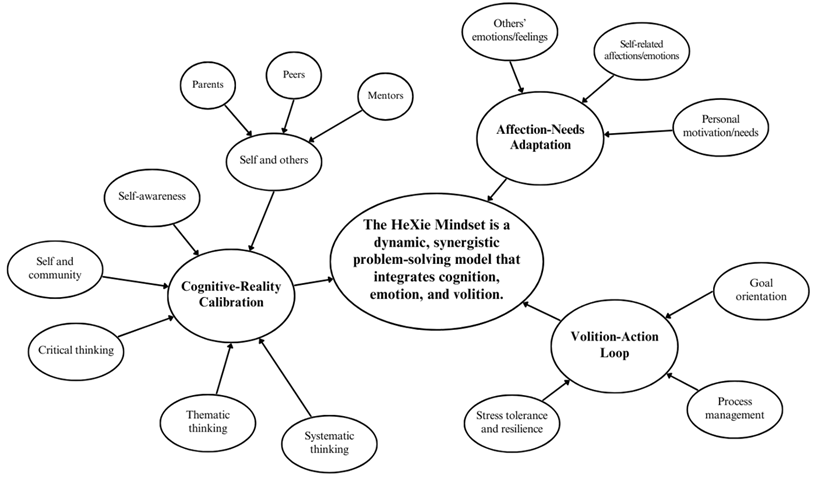Today’s university students are not only navigating academic pressure – they’re also grappling with a world characterised by uncertainty, ambiguity, complexity, changeability and scarcity (UACCS). So, how can we help them not just survive but thrive amid such volatility? One concept from Chinese higher education offers a compelling framework: the HeXie mindset.
The HeXie mindset originates from HeXie management theory, which was first proposed in 1989 by Youmin Xi, the executive president of our institution, as a solution to internal organisational friction. Over time, this theory has evolved into a broader model for navigating UACCS challenges. It was designed to solve organisational friction by balancing two principles:
- He: order, harmony, unity
- Xie: flexibility, collaboration, adaptation.
It has since been extended to education to support student development. However, research on the HeXie mindset in education remains limited and largely top-down. There has been little attention to how students themselves perceive and construct it.
Inside the HeXie mindset: structure and function
We interviewed 23 Chinese university students to understand their perceptions of the HeXie mindset. The consensus was that it is a dynamic and collaborative system of cognition, emotion and volition, designed to solve complex problems and achieve unity between individuals and their environment. Its structure consists of three interrelated dimensions (illustrated below):
- Cognitive reality calibration (accurately understanding and adapting to the real world)
- Emotional needs adaptation (balancing personal emotional needs with the external environment)
- A volition action loop (intention-driven action and effective process management).

1. Cognitive reality calibration
This refers to how students interpret the world and adjust their expectations accordingly. It’s not just about thinking rationally, it’s about understanding oneself in relation to peers, mentors and society. For instance, one interviewee reflected on the contrast between working with close friends versus strategically selecting team members for academic tasks. She realised that friendship doesn’t always translate to effective collaboration, prompting a shift in how she evaluates group dynamics.
2. Affection needs adaptation
This element highlights the role of emotions in learning and self-regulation. Emotional awareness and acceptance are key to maintaining balance. For example, one interviewee described how she faced overwhelming stress during her senior year. Rather than suppressing it, she consciously acknowledged her anxiety, accepted that it was OK to feel down for a while and then restructured her schedule to regain control.
3. Volition action loop
Intentions must turn into action, and this element explains how. It encompasses goal-setting, time management and resilience. For example, one interviewee juggling health challenges with study commitments used “micro-scheduling” (such as studying during her commute) to stay on track. Her story illustrates the power of intentional planning, even in less-than-ideal circumstances.
Together, these processes enable the HeXie mindset to evolve continuously in a cycle of development and transformation.
- Spotlight guide: Get your students workplace-ready
- Collection: Well-being in higher education
- Bluetooth for better health: using tech to support student well-being
How can we help students develop a HeXie mindset?
The HeXie mindset isn’t innate, it’s cultivated. This opens up valuable opportunities for educators, advisers and institutions to create conditions where it can grow.
Figure 1 revealed that the HeXie mindset is a dynamic and collaborative system that synthesises cognition, emotion and volition. However, how does this dynamic collaboration come about? Upon analysing the interview data, we identified three key collaborative mechanisms that students use in their information processing: autonomous integration, reflective cognition and adaptive regulation.
The core dimensions of the HeXie mindset are put into practice by students through the following mechanisms:
Autonomous integration: Cognitive reality calibration involves accurately understanding and adapting to the world, which relies on autonomous integration – actively and independently gathering and incorporating new information.
Reflective cognition: Emotional needs adaptation requires students to thoughtfully reflect on their feelings and experiences to maintain balance, a process supported by reflective cognition.
Adaptive regulation: Finally, the volition action loop, which transforms intentions into effective action, depends on adaptive regulation – the flexible adjustment of strategies during goal pursuit.
Moving through these phases helps students to develop and sustain the HeXie mindset. Here are three strategies to support students in their journey:
Foster self-directed exploration (autonomous integration)
Students often described mindset shifts after stepping outside their comfort zones – for example, joining unfamiliar clubs, pursuing internships or taking initiative in new settings. Providing diverse, accessible opportunities for independent exploration nurtures their ability to integrate new experiences into their personal growth.
Build reflective spaces (reflective cognition)
Reflection helps students process experiences and turn setbacks into insights. Structured practices such as journalling, peer feedback or guided debriefs can deepen this process. A supportive environment that validates their emotions – especially during failure – further enhances their ability to self-correct and evolve.
Design adaptive learning environments (adaptive regulation)
Project-based tasks, real-world challenges and iterative learning models mirror the unpredictability of the UACCS world. These settings strengthen students’ capacity to regulate themselves, adapt strategies and stay resilient when faced with change.
Building a complex mindset takes time. Yet, by grasping the core principles of HeXie management theory and applying its framework to the challenges of the UACCS world, students can gradually cultivate a HeXie mindset – one that enables them to adapt with clarity, act with purpose and grow through uncertainty. In an era filled with both disruption and opportunity, this mindset offers not just resilience but the potential to lead meaningful, creative and fulfilling lives.
Dan Wang is the research engagement manager and Yuchen Wu is the programme development officer, both in the HeXie Management Research Centre and the College of Industry-Entrepreneurs at Xi’an Jiaotong-Liverpool University.
If you would like advice and insight from academics and university staff delivered direct to your inbox each week, sign up for the Campus newsletter.




comment